Fly Fishing 101: How To Choose A Fly Rod
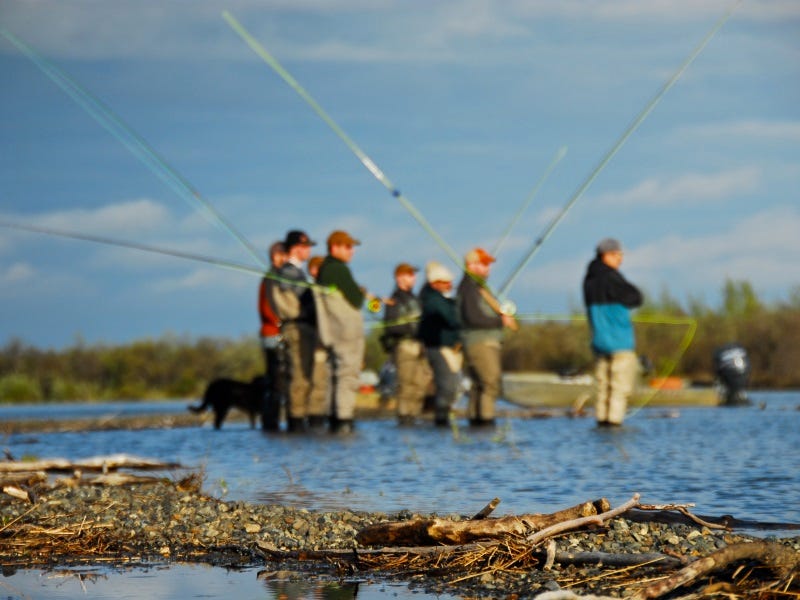
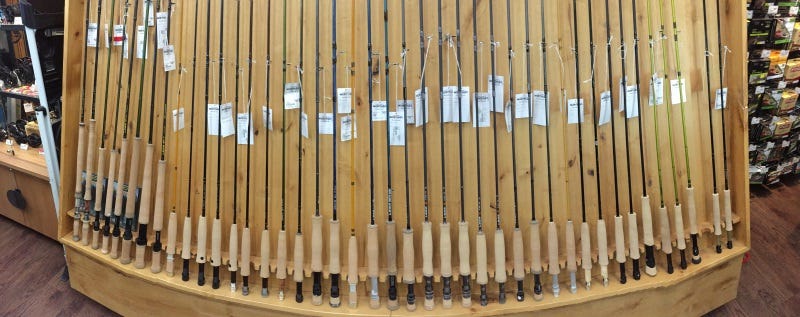 An array of rods may look intimidating, but it shouldn’t. In fact, this is a great time to buy a rod as affordable fly rod options have never been greater. Visit a fly shop and cast a few rods to feel the difference in lengths, weights and actions.
An array of rods may look intimidating, but it shouldn’t. In fact, this is a great time to buy a rod as affordable fly rod options have never been greater. Visit a fly shop and cast a few rods to feel the difference in lengths, weights and actions.An easy way to take the mystery out of fly-fishing is to select the correct fly rod for the type of fishing you plan to do. Fortunately, getting the right rod in your hands is easy, especially if you visit a fly shop and explain what you want out of a rod, and how much you can spend on it. This article should take a lot of the mystery out of buying a rod, whether purchasing for yourself or someone who’s interested in the sport.
Here’s more good news: A quality fly rod does not have to cost a fortune and, if carefully selected, can be used while pursuing a variety of fish species, ranging from trout to tarpon and beyond. Following are details to consider before you purchase a fly rod.
What weight fly rod do I need?
Trout fishing is king in North America and if you are like most anglers, you’ll target rainbow, cutthroat and brown trout most frequently. Trout can grow to large sizes—up to 30 pounds or more—but the standard river fish measures about 12 inches long and weighs less than a pound. Trout grow larger in lakes with the average size running about 16 inches.
To handle these fish you can get away with one rod. The size and strength of fly rods is based on an easy-to-understand progressive scale—lightweight “trout” rods range from 1-weight to 7-weight with heavier rods, which handle larger fish, such as steelhead, salmon, pike, muskie, carp and saltwater species, rating as 8-to 12-weights. For instance, a 1-weight rod is very light and a 12-weight rod covers the other end of the spectrum. If you pursue small panfish you could use a 3 or 4-weight rod; for trout, 4, 5 and 6-weight rods are ideal and the latter, a 6-weight, is serviceable as a steelhead, pike and salmon rod, too.
While no rod is ideal for all situations, a 5 or 6-weight rod gets the job done for trout anglers, whether casting dry flies on small streams or heavy, weighted streamers on broad rivers and lakes.
For steelhead, pike, muskie and salmon, an 8 or 9-weight rod suffices.
For saltwater anglers, depending on which fish they pursue, 7-to 12-weight rods are ideal. A 7-weight works perfectly for bonefish and snook; a 9-weight is great for permit and dolphin; a 10-to 12-weight rod is plenty of rod to fight the largest tarpon, which can weigh 200 pounds or slightly more.
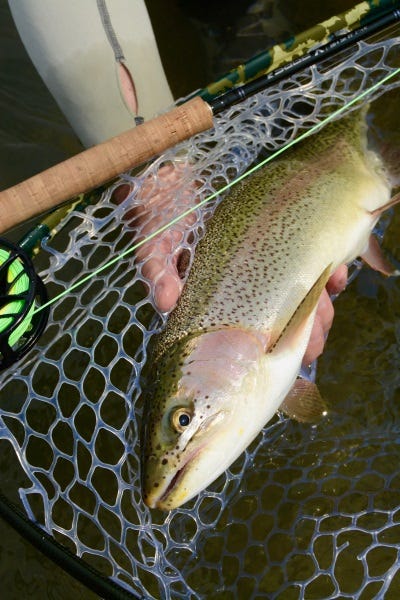 The most versatile rod on the market is a nine-foot long, 5 or 6-weight graphite rod. With a fast action feel, this rod can catch nearly any fish. It is, however, ideal for trout, bass and panfish, but can suffice with steelhead, salmon and pike.
The most versatile rod on the market is a nine-foot long, 5 or 6-weight graphite rod. With a fast action feel, this rod can catch nearly any fish. It is, however, ideal for trout, bass and panfish, but can suffice with steelhead, salmon and pike.What length fly rod is best?
The most common length is nine feet. That length works well in most situations and should serve anglers who primarily target trout. That length allows anglers to keep a cast high, which is especially useful when wading in rivers and lakes.
If you were to buy a nine-foot long 5 or 6-weight rod to fish trout across North America, and many other species, you’d be in business. I have, in fact, landed a 25-pound steelhead and a 50-pound king salmon on a nine-foot 6-weight fly rod, and I have a friend who thought he could land any fish in the world on a 5-weight rod, until he hooked a big tarpon on one. However, if you spend most of your time on small, brushy mountain streams you might want a slightly shorter rod, say an eight-footer, so that you can maneuver more effectively.
If you only fish lakes and reservoirs, especially if you fish from a float-tube, kayak or pontoon boat, you may want a slightly longer rod, say something in the 9.5 to 10-foot long range. That extra length allows you to keep the line slightly higher on your backcast, which facilitates long casts and retrieves.
What does fly-rod action mean? And, which fly-rod action is best for me?
Fly rods come in a variety of actions, which may sound intimidating, but it is not. The most common actions are slow, medium and fast, and each has its attributes.
Think of it this way: a slow-action rod bends from the tip of the rod to the cork handle and is great for subtle presentations with dry flies and small nymphs. Slow-action rods are also great when being super stealthy on picky fish and using light tippets. A light tippet breaks easily and the slow action offers a buffer between the angler and the trout, allowing for soft hook-sets. However, a slow action rod does not facilitate long casts with large, and possibly heavy flies, nor does it offer enough power to fight and land large fish quickly.
Medium-action rods are a compromise between fast-action and slow-action rods and are the easiest rods to cast. They can throw long casts and bend enough to, again, allow a buffer between the angler and the fish, which preserves light tippets. They are strong enough to fight large fish, although not quite as effective at that task as a fast-action rod. Overall, medium-action rods shine in most situations and are a great choice for trout and many other species.
Fast-action rods are the muscle cars of fly-fishing. These rods are not the easiest to cast, although most anglers can quickly pick up the casting stroke these rods require. Fast-action sticks are awesome for bombing out long-distance casts beyond 60 and 70 feet, and they are perfect for casting large nymphs and streamers to trout and other gamefish. And these rods are great tools for fighting fish, including large steelhead, trout, salmon and tarpon. If you’re going after the giants, you should strongly consider a fast-action rod. However, if your fishing requires subtle presentations, especially with light tippet, a fast-action rod is not ideal. These rods mostly bend near the tip and seldom bend much farther than 25 percent of the way down the rod. That means there’s little buffer between the angler and a fish and light tippets are prone to snapping on the hook-set. Look at it this way: Fast-action rod + light tippet + large fish equals disappointed angler. However, fast-action rod + heavy tippet + large fish equals grip-and-grin photo opportunity.
What is the difference between bamboo, graphite and fiberglass fly rods
Graphite, fiberglass and bamboo are the three most common materials use to construct fly rods. I would estimate that 80-to 90-percent of all fly-fishers use modern graphite rods. With good reason: These rods are strong, powerful, nearly impervious to the elements (meaning sun and saltwater), and they come in a variety of weights, lengths and actions, which facilitate every angler on the planet. You can get a graphite rod to chase any fish you choose, ranging from a one-weight graphite rod for panfish, all the way up to a 14-weight for sailfish and marlin.
However, traditionalists like bamboo rods because that is what the first fly rods were made of. These are typically slow-to medium-action rods. However, many an Atlantic salmon, and even tarpon, have been tamed with bamboo sticks. If you’re into tradition and don’t mind the limitations that a bamboo rod provides, these rods may be for you. However, for the general angler, go graphite or go home.
Fiberglass rods followed bamboo and they are serviceable rods that thrive in most situations. They typically offer a slow or medium action, although some modern versions lean toward a “medium-fast” action. These rods are fun to cast and handle fresh and saltwater fish in the appropriate weights.
Overall, again, graphite is the go-to material for modern-day fly-fishers. Any angler who gets their hands on a modern rod from quality brands, such as Sage, Redington, Winston, Echo, Loop, Scott, Thomas & Thomas, and others, should enjoy some great moments on the water. And, these rods may last a lifetime.
 Spey rods are great tools for catching salmon and steelhead. They facilitate long casts with heavy sink tips and large flies.
Spey rods are great tools for catching salmon and steelhead. They facilitate long casts with heavy sink tips and large flies.What is a spey rod and what do spey rods do?
Spey rods have two cork grips (one behind the reel and one in front), versus one cork grip in front of the reel on single-hand rods. That second grip allows anglers to perform specific casts and “lever” the lower end of the rod, which catapults a line and fly over the water. These rods have grown in popularity following the Northwest steelhead/spey movement of the 1990s and 2000s. These rods are ideal for catching salmon, trout and steelhead, although many anglers use them to target other species.
Spey rods are typically longer than single-hand rods and range from 10 feet long all the way to 15 feet long. They are measured with the same rod-weight system as single-hand rods.
Do you need a spey rod? Not necessarily. Most fish that are taken with spey rods can also be taken with single-handers. But, spey rods allow anglers to easily cast heavy lines, sink-tips and large flies, which are typically used to catch steelhead and salmon.
If you pursue those fish, or trout, a two-hand rod is a great choice, but may not be as versatile as a single-hand rod. That said, there are few dedicated steelhead and salmon anglers who wouldn’t choose a spey rod over a single-hander, if given the choice. These rods allow anglers to cast all day with little effort and to do so on heavily vegetated riverbanks where backcast room is almost nonexistent. Got a steelhead or salmon junkie in your house? Got an itch to go after some seriously large fish in large, brawling rivers? If so, a spey rod might be a great choice.
Price: How much should I spend for a good fly rod
We are living in high times for fly-rod enthusiasts. You can spend $1,000 or more on a rod, but you don’t have to. You can get into the game with as simple fly-fishing kit, and there are plenty of good options on the market. These may cost just over $100 to more than $300. Most quality fly rods cost $250 to $600 and these sticks can last a lifetime. If you have the money to spend and you want a particular rod, spend the money and enjoy the heck out of it. If you want to get into the sport and don’t want to break the bank, buy a kit or an individual rod in the $200-to $250 range and give it a try.
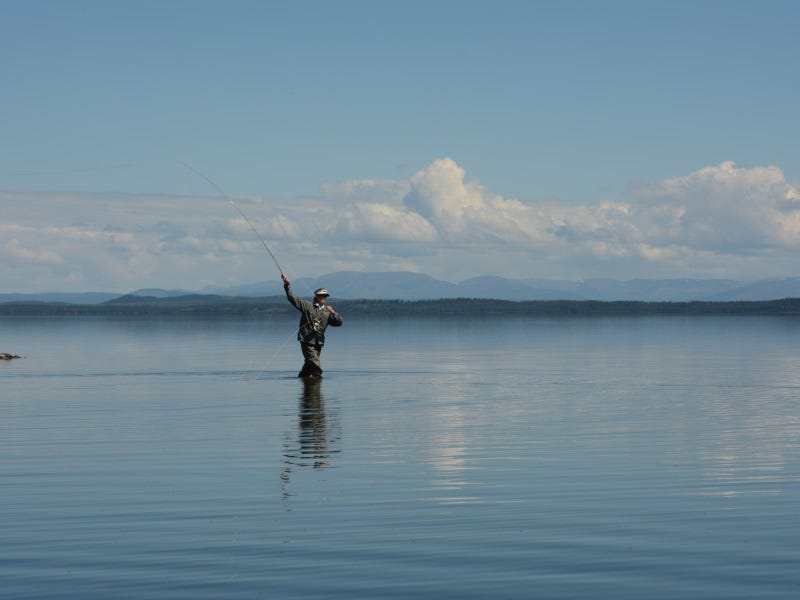 One you match a fly rod to the fish you’re pursuing you’ll enjoy great moments on the water. Here, an angler feels the bend while casting to lake trout and northern pike in the Yukon Territory, Canada.
One you match a fly rod to the fish you’re pursuing you’ll enjoy great moments on the water. Here, an angler feels the bend while casting to lake trout and northern pike in the Yukon Territory, Canada.Fly Rod/Fish Specie Recommendations
What is the ideal fly rod for: Trout and bass
A nine-foot long, 5 or 6-weight, medium-to fast-action rod is ideal for trout fishing in North America.
What is the ideal fly rod for: Northwest salmon and steelhead, and Atlantic salmon
A nine-foot long 7, 8 or 9-weight single-hand rod is an ideal choice. Fast action rods allow anglers to effectively cast sink tips and heavy flies at distance.
In addition, 7, 8 and 9-weight spey rods are good choices. These rods allow anglers to cast for distance, even when fishing with heavy vegetation at their backs, which limits backcast space. In addition, these rods easily throw shooting heads, sink tips and large, heavy flies.
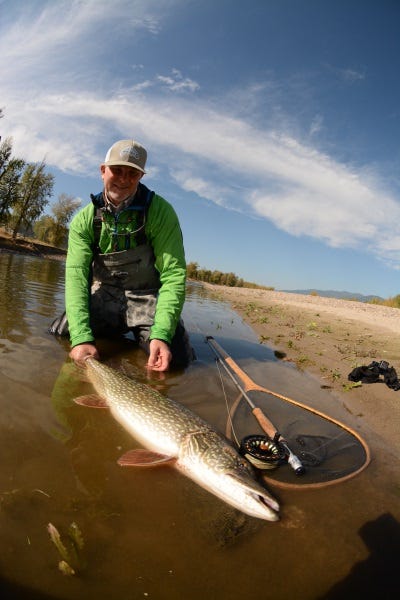 Pike and muskie, and other species, can be easily tamed with 8 and 9-weight fly rods.
Pike and muskie, and other species, can be easily tamed with 8 and 9-weight fly rods.What is the ideal fly rod for: Pike, muskie and carp
Nine-foot long fast-action rods in 8 and 9-weight are ideal for these fish. These rods allow anglers to cast large flies and nymphs (for carp) at distance. And they facilitate quick fights and easy releases on these critters.
What is the ideal fly rod for: Bonefish and snook
Nine-foot long 7 and 8-weight rods are perfect for these fish. You can buy rods specifically designed for saltwater or just use your freshwater rod, as long as you give it a thorough freshwater rinse at the end of each day.
What is the ideal fly rod for: Permit and dolphin (mahi-mahi/dorado)
A nine-foot long nine-weight gives you the muscle to handle these hard fighters. And it allows you to land them somewhat quickly, which is a big bonus when “the man in the brown suit” (meaning a shark) arrives on the scene. Again, you can buy rods specifically designed for saltwater or just use your freshwater rod, as long as you give it a thorough freshwater rinse at the end of each day.
What is the ideal fly rod for: Tarpon, sharks, and billfish
Nine-foot long 10-to 12-weight rods are best for tarpon and suffice, in most cases, for billfish and shark. But heavier rods are available and these are the tools of choice for those pursuing, say, mako sharks and big sailfish or marlin at sea.
